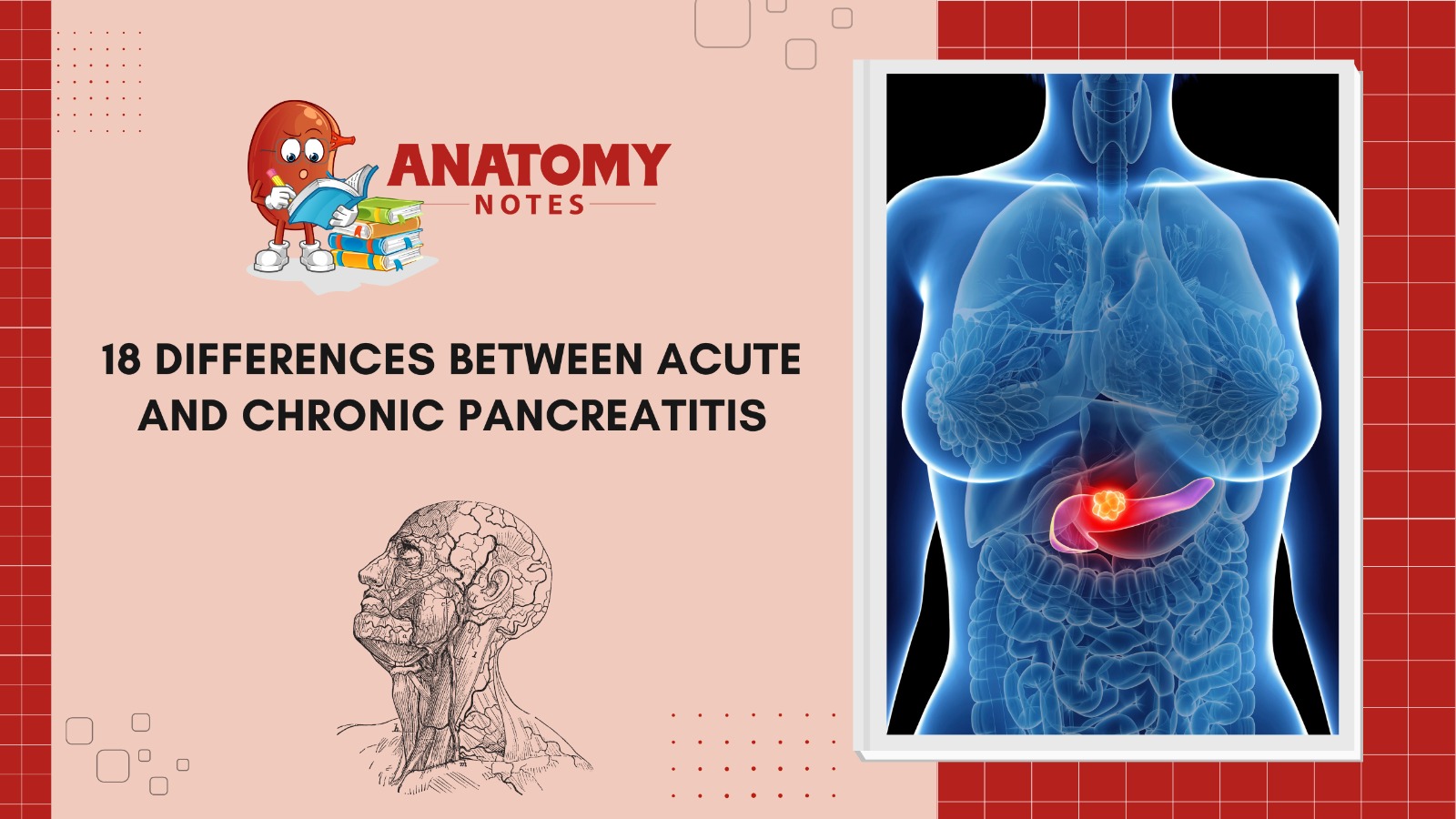Pancreatitis, pancreatic inflammation, may be painful and life-threatening. Acute and chronic pancreatitis are the most prevalent kinds. Accurate diagnosis, treatment, and management require understanding the major distinctions between these two illnesses. Acute and chronic pancreatitis differ in aetiology, clinical appearance, and long-term effects.
Acute pancreatitis is acute pancreatic inflammation that usually heals quickly. Gallstones or heavy alcohol intake activate pancreatic digesting enzymes. Acute pancreatitis begins suddenly with severe stomach pain that spreads to the back, nausea, vomiting, and fever. Pancreatic necrosis, pseudocysts, and systemic inflammation require rapid medical attention in severe situations. Acute pancreatitis may be treated successfully in most cases.
However, chronic pancreatitis is a long-term inflammatory disease. Chronic pancreatitis causes permanent pancreatic damage due to persistent inflammation. Long-term alcohol misuse, genetics, autoimmune illnesses, and recurrent acute pancreatitis are common reasons. Chronic pancreatitis symptoms are minor but might worsen with time. Due to pancreatic cell death, patients may develop diabetes, stomach discomfort, digestive issues, weight loss, and malabsorption of nutrients.
Acute and chronic pancreatitis differ beyond clinical manifestation. Acute pancreatitis is reversible, as the pancreas recovers from inflammation. Chronic pancreatitis is irreversible and causes pancreatic duct strictures, fibrous tissue, and calcifications. Chronic discomfort, malnutrition, and intestinal dysfunction might occur.
In conclusion, acute and chronic pancreatitis are two separate forms of pancreatic inflammation with different symptoms, causes, and long-term effects. Treatment planning and management depend on accurate diagnosis and distinction. Healthcare workers can enhance patient care and quality of life by knowing acute and chronic pancreatitis.
|
S. No. |
Aspect |
Acute Pancreatitis |
Chronic Pancreatitis |
|
1 |
Onset |
Sudden and acute onset of inflammation |
Gradual and long-term inflammation |
|
2 |
Duration |
Short-term condition (days to weeks) |
Long-lasting condition (months to years) |
|
3 |
Inflammation |
Ongoing inflammation of the pancreas |
|
|
4 |
Severity |
Can range from mild to severe symptoms |
Generally presents with persistent symptoms |
|
5 |
Symptoms |
Abdominal pain, nausea, vomiting, fever |
Abdominal pain, weight loss, digestive issues |
|
6 |
Complications |
Can lead to pancreatic necrosis or infection |
Can lead to complications like diabetes, malabsorption |
|
7 |
Reversibility |
Can be reversible with proper treatment |
Often irreversible, leading to permanent damage |
|
8 |
Risk Factors |
Gallstones, alcohol abuse, high triglycerides |
Alcohol abuse, smoking, genetic factors |
|
9 |
Imaging Findings |
Enlarged pancreas, fluid collections |
Pancreatic calcifications, atrophy of the pancreas |
|
10 |
Treatment |
Hospitalization, pain management, fluid resuscitation |
Lifestyle changes, pain management, enzyme replacement |
|
11 |
Recurrence |
Generally does not recur after resolution |
Can have recurrent flare-ups or exacerbations |
|
12 |
Pancreatic Function |
Temporary impairment, can recover fully |
Gradual decline in pancreatic function over time |
|
13 |
Diagnostic Tests |
Blood tests (amylase, lipase), imaging (CT, MRI) |
Blood tests (amylase, lipase), imaging (CT, MRI), pancreatic function tests |
|
14 |
Etiology |
Often caused by gallstones or alcohol consumption |
Prolonged inflammation, long-term damage to the pancreas |
|
15 |
Age Distribution |
Can affect individuals of any age |
More common in older individuals |
|
16 |
Prognosis |
Generally good with prompt treatment |
Varied prognosis depending on severity and complications |
|
17 |
Risk of Cancer |
Low risk of developing pancreatic cancer |
Increased risk of pancreatic cancer in some cases |
|
18 |
Management |
Acute episode management and prevention |
Long-term management and symptom control |
Frequently Asked Questions (FAQs)
Q1: What exactly is pancreatitis?
The inflammation of the pancreas, a gland situated beneath the stomach, is a defining feature of pancreatitis. Acute means it happens abruptly and lasts a short while, while chronic means it grows gradually and lasts for a longer time.
Q2: Acute pancreatitis has what causes?
Gallstones and binge drinking are the two leading causes of acute pancreatitis. Gallstones can obstruct the pancreatic duct, causing a buildup of digestive enzymes and a subsequent inflammatory response. Alcohol use can irritate and harm the pancreas, which results in an inflammatory reaction.
Q:3 What signs and symptoms of acute pancreatitis are there?
Acute pancreatitis symptoms include a fever, nausea, vomiting, enlarged and painful belly, and intense stomach pain that travels to the back. Pancreatic necrosis and systemic inflammation are consequences that can happen in extreme situations.
Q4: How is acute pancreatitis identified?
The diagnosis of acute pancreatitis is often made using a combination of the patient’s medical history, physical examination, blood testing (elevated pancreatic enzyme levels), and imaging tests like ultrasound, CT scans, or MRI.
Q5: Is acute pancreatitis treatable?
Acute pancreatitis is treatable. Supportive therapy is used to treat symptoms, including fasting to rest the pancreas, intravenous fluids to stay hydrated, pain relief, and sometimes antibiotics if an infection is present. Hospitalisation could be necessary in serious situations.
Q:6 Why does chronic pancreatitis occur?
Chronic pancreatitis is frequently brought on by long-term alcohol addiction, however it can also be brought on by autoimmune illnesses, genetic susceptibility, and recurring acute pancreatitis episodes.
Q:7 What are the signs and symptoms of persistent pancreatitis?
Constant stomach discomfort, weight loss, loose or oily stools, diarrhoea, nausea, and vomiting are all possible signs of chronic pancreatitis. Damage to pancreatic tissue over time may result in issues including diabetes and nutrition loss.
Q:8 Eighth question: How is chronic pancreatitis identified?
The diagnosis of chronic pancreatitis combines medical history, physical examination, blood tests (including pancreatic enzyme levels), imaging tests (CT scan, MRI), and occasionally specialised tests like endoscopic retrograde cholangiopancreatography (ERCP) or endoscopic ultrasound (EUS).
Q:9 Is it possible to treat chronic pancreatitis?
Chronic pancreatitis has no known treatment and is a gradual, permanent disorder. However, the purpose of treatment is to control symptoms, avoid problems, and enhance quality of life. A treatment approach frequently includes dietary assistance, pancreatic enzyme supplements, lifestyle changes, and pain control.
Q10: Are there any side effects from pancreatitis?
Yes, problems from pancreatitis can arise from both acute and chronic cases. Organ failure, pancreatic necrosis, pseudocysts, and infection can all be consequences of acute pancreatitis. In addition to chronic pain, starvation, diabetes, pancreatic calcifications, and an elevated risk of pancreatic cancer, chronic pancreatitis can also result in malnutrition.




